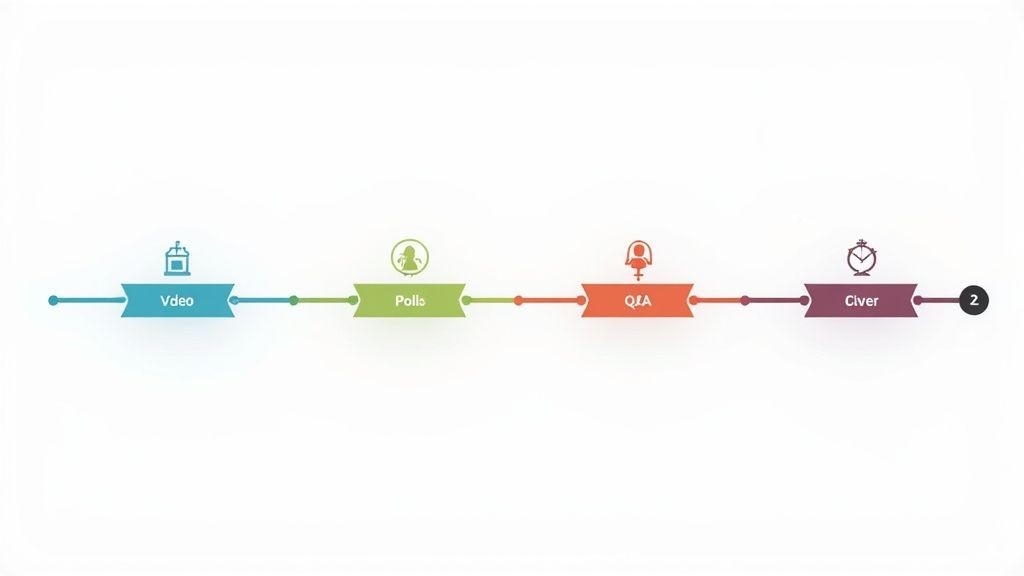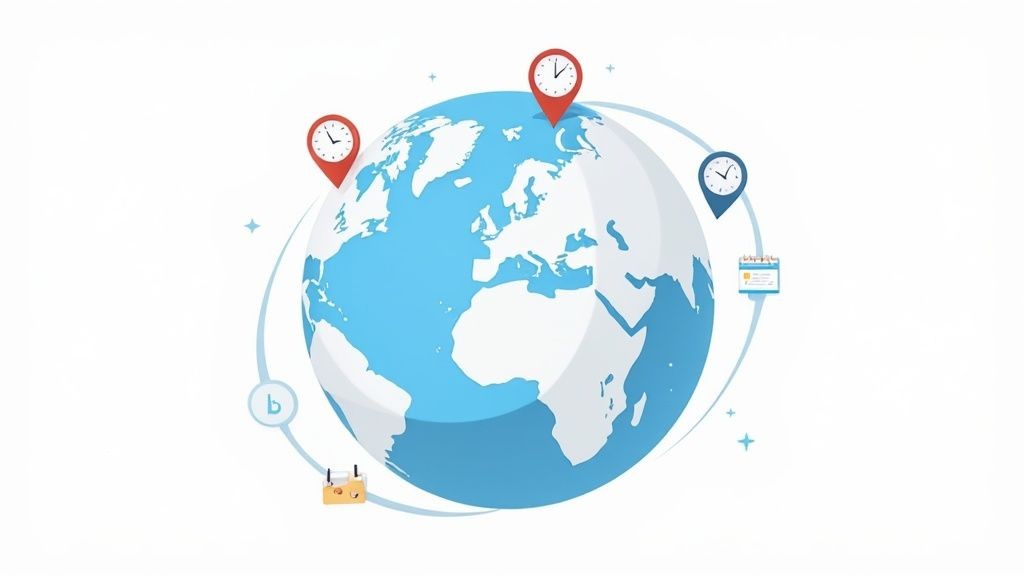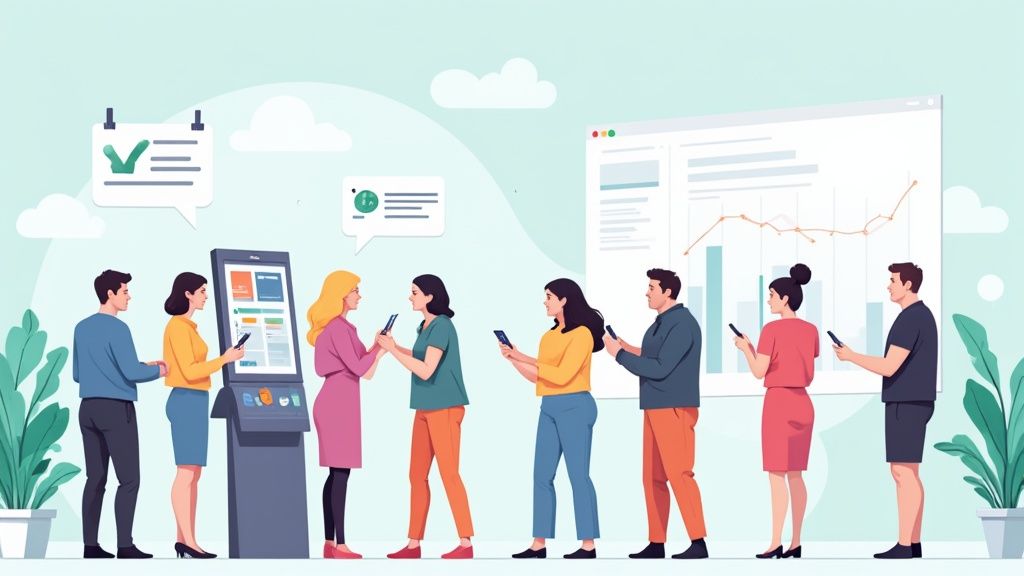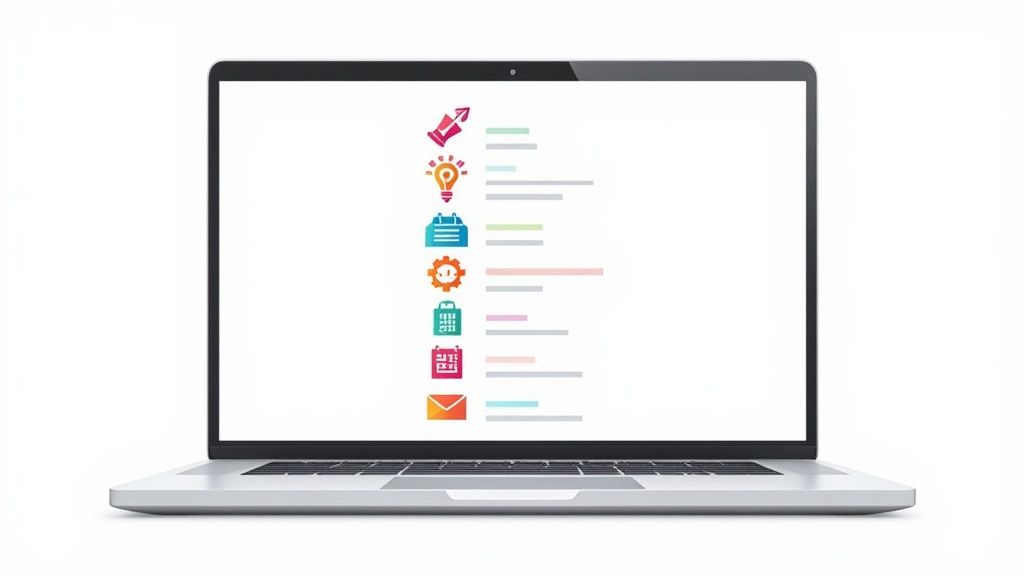In a world where virtual gatherings are the new standard, simply broadcasting a presentation online is no longer sufficient. The distinction between a forgettable webinar and a landmark virtual conference is rooted in a specific, deliberate set of strategies. As digital event platforms mature, so must our approach to planning, execution, and follow-up. The challenge is no longer about getting people to attend; it's about making them glad they did, creating an experience that feels valuable, engaging, and worthy of their time.
This guide moves beyond the elementary advice of "test your webcam" and "have a good internet connection." Instead, we will unpack 10 essential virtual conference best practices meticulously refined for today's sophisticated digital audiences. These strategies are designed to help you create truly impactful and memorable online events that resonate long after the final session ends. We'll provide a comprehensive roadmap covering everything from sophisticated technical readiness and dynamic content pacing to fostering genuine networking and maximizing post-event engagement.
Whether you're an experienced event marketer, a corporate organizer planning a major digital summit, or a small business owner hosting a key product launch, these proven practices will equip you with a clear framework for success. Our goal is to ensure your attendees don't just log on out of obligation, but lean in with genuine interest. By implementing these actionable insights, you can transform your next virtual event from a simple online meeting into an unforgettable, must-attend experience that delivers tangible results for your brand and a rewarding experience for your audience.
1. Technical Setup and Testing
A flawless technical execution is the bedrock of any successful virtual conference. Without it, even the most compelling content and speakers can be undermined by glitches, poor audio, or connection issues. This foundational practice involves a comprehensive pre-conference preparation phase where every technical component is rigorously tested. This includes verifying internet bandwidth, stress-testing the virtual event platform, and checking all hardware like cameras, microphones, and lighting. The goal is to identify and resolve potential points of failure before they can impact the live attendee experience, thereby protecting your event's credibility.

Major events, such as the virtual World Economic Forum and large-scale Cisco WebEx summits, exemplify this principle by implementing redundant systems and dedicated technical crews. They understand that a smooth, professional broadcast is non-negotiable for audience engagement and retention. One of the most critical virtual conference best practices is to treat the technical setup not as a pre-flight check, but as a core part of the event strategy itself.
Actionable Implementation Tips
To ensure your event runs smoothly, integrate these testing protocols into your planning:
- Conduct a Full Dry Run: Schedule a complete, end-to-end rehearsal with all speakers and moderators 24-48 hours before the event. Use the actual platform and equipment to simulate the live experience, from login to the final Q&A.
- Test from the Presentation Location: All speakers and key staff should test their connections and equipment from the exact location they will be presenting from on event day. A home Wi-Fi network can perform very differently from an office network.
- Verify All Integrations: Test every interactive tool you plan to use. This includes launching polls, running Q&A sessions, facilitating breakout rooms, and ensuring chat functions work as expected. Don't assume an integration will work just because the platform supports it. A detailed checklist can be invaluable here; you can find a comprehensive guide for your technical setup in this virtual event planning checklist.
- Prepare a Troubleshooting Guide: Create a simple, one-page guide for speakers and attendees covering common issues like refreshing the browser, checking audio settings, or rejoining the session. Have a dedicated IT support channel available during the conference for immediate assistance.
2. Engaging Content Structure and Pacing
In a virtual environment, attendee attention is a finite and fragile resource. Unlike in-person events where audiences are captive, virtual attendees are just one click away from a distracting email or task. Therefore, strategically designing content structure and pacing is not just a good idea; it's a critical component for success. This practice involves breaking away from the traditional hour-long lecture format and adopting a dynamic, multi-format approach with shorter segments, intentional breaks, and compelling storytelling to hold audience interest.

Pioneered by organizations like TED with their famous 18-minute talk limit, this model acknowledges that virtual attention spans are significantly shorter. Major tech conferences like Google Cloud Next and HubSpot's INBOUND have embraced this by mixing keynote speeches with quick-fire interactive demos, panel discussions, and pre-recorded videos. This variety combats digital fatigue and keeps the audience mentally invested. Implementing this as one of your core virtual conference best practices means treating content not as a monologue but as an intentionally paced and engaging dialogue.
Actionable Implementation Tips
To keep your virtual audience hooked from start to finish, architect your content with these principles:
- Adopt the 10-20-30 Rule: A popular guideline for presentations is to use no more than 10 slides, last no longer than 20 minutes, and use a minimum 30-point font. This forces speakers to be concise and visually clear, which is ideal for screen-based viewing.
- Create a Narrative Arc: Structure each session like a story with a clear beginning (the problem), middle (the journey or solution), and end (the key takeaway or call to action). A strong narrative is far more memorable than a list of facts.
- Use Pattern Interrupts: Intentionally break the flow of a presentation to re-engage the audience. Every 8-10 minutes, introduce a "pattern interrupt" such as launching a quick poll, asking a direct question in the chat, showing an unexpected video clip, or switching speakers.
- Build in Micro-Breaks: Schedule short, 5-minute breaks at least once per hour. Encourage attendees to stand up, stretch, or grab a drink. Announcing these breaks in advance helps manage expectations and gives attendees a moment to reset without disengaging completely. For more insights on building a content strategy that captivates, explore this guide on powerful event content marketing.
3. Interactive Networking Features
One of the biggest challenges for virtual events is replicating the spontaneous, high-value networking that occurs at in-person conferences. Simply streaming content isn't enough; attendees crave connection. Implementing interactive networking features directly addresses this gap by creating structured and informal opportunities for participants to meet, share ideas, and build professional relationships. This involves leveraging platform tools like AI-powered matchmaking, themed breakout rooms, and virtual lounges to facilitate meaningful interactions, transforming a passive viewing experience into an active, engaging community event.

Pioneering virtual events like Web Summit and platforms such as Hopin and Airmeet demonstrate the power of intentional networking design. They use AI matchmaking to connect attendees with shared interests and integrated one-on-one video chat features that mimic "coffee chats." By engineering these moments of connection, organizers can deliver the crucial ROI that attendees expect from a conference. This focus on community is one of the most vital virtual conference best practices for driving attendee satisfaction and ensuring they return for future events.
Actionable Implementation Tips
To foster a vibrant networking environment, integrate these strategies into your event agenda:
- Schedule Dedicated Networking Blocks: Don't leave networking to chance. Weave short, 15-to-20-minute dedicated networking breaks into the schedule between sessions. This gives attendees explicit permission and time to connect without missing key content.
- Utilize AI Matchmaking: Leverage platform features that use attendee profile data (like industry, goals, and interests) to suggest relevant connections. This removes the guesswork and helps participants find the right people to talk to more efficiently.
- Create Themed Breakout Rooms: Instead of generic "lounge" areas, create smaller, topic-focused breakout rooms (4-6 people is ideal) based on session themes or common challenges. Provide conversation starters or a facilitator in each room to get the discussion flowing.
- Offer Multiple Formats: Accommodate different comfort levels by providing both video-based networking (like one-on-one speed networking) and text-based options (such as dedicated Slack or Discord channels). This ensures everyone has a way to participate.
4. Multi-Timezone Accessibility
One of the greatest advantages of a virtual conference is its ability to transcend geographical boundaries, but this benefit is only realized if the event is accessible to a global audience. Strategic scheduling is crucial for accommodating attendees across different time zones. By designing an event that isn't limited to a single 9-to-5 window, you demonstrate inclusivity and exponentially increase your potential reach and impact. This practice involves more than just picking a convenient time; it's about building an event architecture that caters to diverse schedules.

Major global events like AWS re:Invent and Salesforce's Dreamforce have mastered this by offering repeated keynotes and breakout sessions tailored to the Americas, EMEA, and APAC regions. Similarly, GitHub Universe has adopted a 48-hour continuous schedule to ensure everyone has a chance to participate live. Implementing these multi-timezone strategies is one of the most effective virtual conference best practices for transforming a regional event into a truly global one, ensuring no one is excluded due to their location.
Actionable Implementation Tips
To make your conference globally accessible, consider these scheduling and content strategies:
- Offer Multiple Live Slots: Schedule your most important sessions, like keynotes and major panels, at least two or three times to cover primary time zone clusters (e.g., one for Asia-Pacific, one for Europe/Africa, and one for the Americas).
- Provide Rapid On-Demand Access: Record all sessions and make them available for on-demand viewing as quickly as possible, ideally within 2-4 hours of the live broadcast. Accompany recordings with downloadable slides and transcripts to enhance accessibility.
- Use Clear Time Zone Communication: Embed a timezone converter directly on your registration and agenda pages to prevent confusion. All communications should clearly state the event times in multiple major time zones (e.g., PST / EST / GMT / SGT). Using a tool to manage this can be a lifesaver; you can learn more about how to handle this with a meeting time zone converter.
- Create Asynchronous Engagement: Don't limit interaction to live Q&A. Set up dedicated channels in a community platform like Slack or Discord where attendees can ask questions and discuss topics with speakers and peers at any time, regardless of when they watch the session.
5. Professional Visual Design and Branding
A strong visual identity is what separates a forgettable webinar from a premium virtual conference. Professional visual design and branding infuse every touchpoint of your event with a sense of quality, cohesion, and credibility. This practice involves creating and consistently applying a unique aesthetic across the event platform, marketing materials, presentations, and digital backdrops. The goal is to build a professional, immersive environment that reinforces your brand’s authority and makes attendees feel they are part of a high-value, well-produced experience.
Iconic events like Apple's WWDC and the Adobe Summit master this principle, using distinctive visual identities to create a sense of occasion and exclusivity. They demonstrate that thoughtful branding is not just decoration; it's a strategic tool that elevates the perceived value of the content and the overall event. Implementing professional branding is one of the most impactful virtual conference best practices because it directly shapes attendee perception and justifies their investment of time and money.
Actionable Implementation Tips
To create a polished and memorable visual experience, integrate these design principles into your planning:
- Develop a Conference Brand Guide: Create a specific style guide for your event that details color palettes, typography, logo usage, and graphic styles. This guide ensures consistency across all platforms, from social media promotions to the live event interface.
- Invest in a Professional Virtual Stage: Move beyond default webcam backgrounds. Design custom virtual sets, animated lower-thirds for speaker names, and branded transition screens. This level of production quality significantly boosts the event's professional feel.
- Provide Branded Speaker Kits: Equip all your presenters with a comprehensive kit that includes branded slide deck templates, virtual background options, and a one-sheet on presentation best practices. This ensures a consistent look and feel across all sessions, regardless of who is presenting.
- Ensure Visual Consistency in Communications: Your branding should extend to every piece of communication. This includes registration pages, confirmation emails, and event reminders. Using consistent visuals in your "add to calendar" links, for instance, reinforces the event identity right from the moment an attendee registers.
6. Comprehensive Attendee Onboarding and Support
A smooth attendee experience begins long before the opening keynote. Comprehensive onboarding is a critical practice that transforms attendees from passive viewers into active participants by eliminating technical friction and confusion. This process involves proactively educating your audience on how to navigate the virtual platform, access content, and engage with interactive features. The goal is to ensure every attendee feels confident and prepared, so they can focus on the event's value instead of wrestling with technology.
Major events like Salesforce's Dreamforce and Adobe Summit excel at this by providing interactive platform tours, detailed participant guides, and pre-conference prep sessions. They recognize that a well-prepared attendee is an engaged attendee. Treating onboarding and support as an essential component of your event strategy is one of the most impactful virtual conference best practices you can adopt, directly influencing satisfaction rates and ensuring attendees can maximize their participation from the moment they log in.
Actionable Implementation Tips
To set your attendees up for success, build a robust onboarding and support framework:
- Create a Timed Communication Sequence: Don't overload attendees with a single information dump. Send a series of onboarding emails 2 weeks, 1 week, and 24 hours before the event, each with a specific focus, from platform login instructions to agenda highlights.
- Develop "How-To" Video Tutorials: Produce short, digestible video guides (2-3 minutes each) that demonstrate key platform features. Cover essential functions like navigating the agenda, joining a session, participating in a poll, and using the networking lounge.
- Establish Multi-Channel Support: Offer support through various channels to accommodate different user preferences. A live chat for instant help during the event, a dedicated email address for less urgent queries, and even a phone number for critical issues can make a huge difference.
- Provide Downloadable Quick-Start Guides: Create a simple, visually appealing one-page PDF that attendees can download or print. This guide should serve as a quick reference for logging in, finding sessions, and getting technical help, ensuring information is always accessible.
7. Real-Time Engagement and Analytics
Understanding what captivates your audience while the event is live is a superpower in the virtual conference world. Real-time engagement and analytics involve actively monitoring attendee behavior and interaction data as it happens. This data-driven approach allows organizers to move beyond passive broadcasting and make informed, on-the-fly adjustments to content, pacing, and moderation. By tracking metrics like session attendance, chat activity, poll responses, and resource downloads, you can identify which topics are resonating and where engagement is dropping off, enabling immediate intervention.
Platforms like Hopin, Hubilo, and ON24 have built their reputations on providing robust, real-time dashboards that visualize this data. For instance, a conference organizer might notice a session's chat is unusually quiet. Using this insight, they can prompt the moderator to launch a quick poll or pose a direct question to the audience to re-energize the discussion. This proactive management is one of the most effective virtual conference best practices for transforming a static presentation into a dynamic, responsive experience that delivers measurable value.
Actionable Implementation Tips
To leverage live data for a more impactful event, follow these steps:
- Establish Key Metrics Beforehand: Define your success metrics before the event starts. These could include session attendance rate, average viewing time, Q&A submissions, poll participation, and post-session survey scores.
- Assign a Dedicated Monitor: Designate a team member to be the "engagement monitor." Their sole responsibility during live sessions is to watch the analytics dashboard and communicate insights or red flags (like a sudden drop in attendees) to the event moderator or producer.
- Use Pulse Surveys: Deploy short, one-question "pulse" surveys during longer sessions to gauge audience understanding, satisfaction, or energy levels. This provides instant feedback that can help the speaker adjust their delivery.
- Create a Live Dashboard View: Set up a shared screen or dashboard for the core event team to monitor key metrics collectively. This creates a "mission control" environment and ensures everyone is aligned on the event's real-time performance. For a deeper dive into maximizing event reach from the very beginning, consider how effective calendar invitations can drive initial registration and attendance, a topic covered extensively in this ultimate guide to calendar marketing.
8. Speaker Training and Preparation Programs
A compelling speaker can captivate a live audience with charisma alone, but the virtual stage demands a different skill set. Effective speaker training and preparation are crucial for translating in-person energy into on-screen engagement. This practice involves creating structured programs to equip speakers with the technical skills and presentation techniques needed for a virtual environment. It moves beyond a simple tech check to encompass coaching on camera presence, pacing, and interactive element usage, ensuring every presenter is confident and polished.
World-class events like the TED Conference and Salesforce’s Dreamforce invest heavily in speaker academies for this very reason. They recognize that a speaker's delivery is as important as their content. By providing dedicated coaching and resources, they elevate the quality of every session and ensure a consistent, professional experience for attendees. Implementing this as one of your core virtual conference best practices is a direct investment in your event’s content quality and overall success.
Actionable Implementation Tips
To elevate your speakers' performances, implement a structured preparation program:
- Provide a Speaker Best Practices Guide: Create a comprehensive guide covering ideal camera angles, lighting setups, virtual backgrounds, and content pacing. Include recommendations for attire and tips on engaging a remote audience they cannot see.
- Schedule Mandatory Tech Rehearsals: A mandatory 30-minute tech rehearsal with each speaker 24-48 hours before their session is non-negotiable. Use this time to test their audio, video, and internet connection from their exact presentation location, and run through slide sharing and interactive tools.
- Assign a Dedicated Producer: Assign a session producer or moderator to each speaker. This person acts as their technical co-pilot during the live event, managing Q&A, launching polls, and providing real-time support so the speaker can focus solely on their delivery.
- Record Rehearsals for Feedback: Record the technical rehearsal or a separate practice run. This allows speakers to review their own performance, identify areas for improvement in their pacing or delivery, and get comfortable with being on camera. This step can dramatically boost a presenter's confidence and polish.
9. Thoughtful Sponsor and Exhibitor Integration
Successful monetization of a virtual conference hinges on integrating sponsors and exhibitors in a way that provides them with value without alienating your audience. This practice moves beyond simple logo placements and disruptive ads, focusing instead on creating strategic partnerships where sponsors contribute genuinely valuable content and experiences. The goal is to weave sponsor presence into the fabric of the event, making it a natural and beneficial part of the attendee journey rather than an intrusive commercial break. This approach protects the attendee experience while delivering clear ROI for partners.
Major tech conferences like AWS re:Invent and Dreamforce excel at this, creating dedicated virtual partner pavilions and sponsored breakout sessions that attendees actively seek out. They understand that the most effective sponsorships are those that align with the event's core educational mission. Implementing thoughtful sponsor integration is one of the most critical virtual conference best practices because it directly links event revenue to attendee satisfaction, creating a sustainable model where everyone wins.
Actionable Implementation Tips
To integrate sponsors effectively without compromising the attendee experience, consider these strategies:
- Vet Sponsor Content for Quality: Require sponsors to provide genuine value, such as educational workshops, expert panels, or insightful case studies, rather than straight product pitches. Ensure their sessions meet the same quality standards as your primary conference content.
- Create Dedicated Sponsor Tracks: Organize sponsored sessions into a separate, clearly labeled track. This gives attendees control over their experience, allowing them to opt-in to commercial content that interests them without feeling like it's being forced upon them.
- Offer Exclusive Networking Lounges: Provide sponsors with dedicated virtual lounges or breakout rooms where they can host private meetings, conduct live demos, or facilitate themed networking discussions. This creates high-value, direct interaction opportunities.
- Develop Tiered Sponsorship Packages: Design clear sponsorship tiers with transparent ROI metrics. Offer a menu of options, from branded sessions and virtual booths to sponsored wellness breaks or gamification prizes, allowing partners to choose the activation that best fits their goals. For more on structuring your event schedule to include these elements, see this conference agenda guide.
10. Post-Conference Engagement and Content Repurposing
The value of your virtual conference should not end when the live stream does. A strategic post-conference plan extends the event's lifecycle, maximizes its impact, and nurtures the community you've built. This practice involves making session content available on-demand, initiating follow-up communications, and transforming recordings into a diverse array of new content assets. This approach significantly boosts your event's return on investment by creating long-term value and keeping your audience engaged long after the final session.
Industry leaders like AWS re:Invent and HubSpot's INBOUND conference have mastered this strategy. AWS provides on-demand access to its session library for months, while HubSpot repurposes its INBOUND content into comprehensive blog posts, podcast series, and social media clips. This continuous stream of high-value content keeps the conversation going and reinforces their authority in the industry. Implementing robust post-event strategies is one of the most critical virtual conference best practices for building a lasting community and proving long-term event ROI.
Actionable Implementation Tips
To extend the life and value of your conference, integrate these post-event tactics:
- Provide Swift On-Demand Access: Post all session recordings within 24-48 hours. Accompany them with downloadable slide decks and transcripts to cater to different learning preferences and improve accessibility.
- Create Snackable Social Content: Edit longer session recordings into 5-10 minute highlight reels or short, impactful clips. These are perfect for sharing on social media platforms to reach a wider audience and drive traffic back to the full recordings.
- Launch a Community Hub: Create a dedicated space for attendees to connect post-event, such as a private Slack channel, Circle community, or LinkedIn group. This fosters networking and allows discussions to continue organically.
- Execute a Strategic Email Follow-Up: Send a series of post-conference emails. Start with a thank you and a link to the recordings, followed by key takeaways, a survey request, and eventually, an announcement for your next event.
- Repurpose into Multiple Formats: Transform your content to reach new audiences. Extract audio to create a podcast series, use session summaries to generate in-depth blog posts, and compile key statistics into shareable infographics.
10-Point Virtual Conference Best Practices Comparison
| Item | Complexity 🔄 | Resource Requirements ⚡ | Expected Outcomes 📊 | Key Advantages ⭐ | Ideal Use Cases 💡 |
|---|---|---|---|---|---|
| Technical Setup and Testing | High — extensive rehearsals and redundancy checks | High — IT staff, test equipment, backup internet | 📊 Fewer technical failures; smoother live delivery | ⭐ Professional, reliable presentation quality | 💡 Large-scale or high-stakes live sessions |
| Engaging Content Structure and Pacing | Medium — requires content planning and segmenting | Medium — creative resources, multimedia assets | 📊 Higher engagement and retention (short segments) | ⭐ Keeps attention; diverse learning approaches | 💡 Long agendas needing sustained attention |
| Interactive Networking Features | High — platform integration and session orchestration | High — advanced platform, matchmaking tech, moderators | 📊 Increased ROI for attendees; extended engagement | ⭐ Drives connections and lead generation | 💡 B2B events focused on networking and deals |
| Multi-Timezone Accessibility | Medium — scheduling complexity and coordination | Medium — recording infrastructure, subtitles, staffing | 📊 Broader global reach; higher total attendance | ⭐ Inclusive access across regions | 💡 Global audiences or recurring international events |
| Professional Visual Design and Branding | Medium — consistent design standards to enforce | High — designers, production, branded assets | 📊 Stronger brand perception; perceived value uplift | ⭐ Enhances credibility and memorability | 💡 Brand-led conferences and product launches |
| Comprehensive Attendee Onboarding and Support | Medium — pre-event comms and support planning | High — support team, documentation, tutorials | 📊 Reduced support tickets; higher attendance rates | ⭐ Better attendee experience and lower churn | 💡 New platforms or non-technical audiences |
| Real-Time Engagement and Analytics | Medium — dashboard setup and metric definitions | High — analytics tools, integration, analysts | 📊 Immediate insights; data-driven adjustments | ⭐ Optimizes content and measures ROI | 💡 Data-driven organizers and continuous improvement |
| Speaker Training and Preparation Programs | Medium — scheduling and coaching coordination | Medium — coaches, rehearsal time, producer support | 📊 Higher presentation quality and engagement | ⭐ Consistent, confident speaker delivery | 💡 Events with many external or high-profile speakers |
| Thoughtful Sponsor and Exhibitor Integration | Medium — curation and non-intrusive placement | Medium–High — exhibitor platform, moderation, metrics | 📊 Revenue generation balanced with attendee value | ⭐ Funds event while adding relevant value | 💡 Monetization-focused events needing sponsor ROI |
| Post-Conference Engagement and Content Repurposing | Medium — content editing and community management | Medium — editors, hosting, community tools | 📊 Extended ROI; continued engagement post-event | ⭐ Maximizes lifetime value of sessions | 💡 Events seeking long-term lead nurture and content marketing |
From Planning to Lasting Impact: Your Next Steps
Executing a world-class virtual conference is no longer about simply replicating an in-person event online. It is about architecting a unique, digital-first experience that captivates, connects, and delivers lasting value. Throughout this guide, we've explored the essential pillars that transform a standard webinar into a landmark event. From the foundational necessity of rigorous technical testing to the nuanced art of post-conference content repurposing, each practice contributes to a cohesive and impactful attendee journey.
The virtual landscape is crowded, and attendee expectations are higher than ever. Simply having great speakers is not enough. Success lies in the thoughtful integration of every element discussed. It's about designing a content structure that respects digital fatigue, implementing interactive tools that spark genuine conversation, and providing comprehensive support that makes every participant feel valued and heard. These aren't just items on a checklist; they are strategic components of a holistic event ecosystem.
Key Takeaways for Your Next Virtual Event
As you move from planning to execution, remember that the most successful virtual conferences are built on a foundation of empathy for the attendee. They anticipate needs, remove friction, and consistently deliver moments of delight and insight.
To crystallize your strategy, focus on these core principles:
- Prioritize the Attendee Journey: Map out every touchpoint, from the first registration confirmation to the final post-event survey. How can you make each step seamless and engaging?
- Engagement is an Active Verb: Don't expect attendees to engage on their own. Proactively build in opportunities for interaction through polls, Q&A sessions, breakout rooms, and gamification.
- Technology Serves the Experience, Not the Other Way Around: Select your tech stack based on the experience you want to create. Your platform, analytics tools, and integrations should be enablers of your vision, not limitations.
- The Event Lifecycle Extends Beyond "Live": The true impact of your conference is realized in the weeks and months that follow. A robust strategy for post-event engagement and content repurposing is non-negotiable for maximizing your ROI.
Turning Best Practices into Standard Practice
Mastering these virtual conference best practices is what separates forgettable online meetings from industry-defining events. The difference is in the details: the speaker who feels confident and prepared because of your training program, the sponsor who sees tangible lead generation from a well-integrated virtual booth, and the attendee who effortlessly joins every session because the calendar reminders worked flawlessly.
By internalizing these concepts, you shift from being a reactive event coordinator to a proactive experience designer. You build a reputation for quality and reliability, ensuring that when your next event is announced, your target audience doesn't just see another webinar-they see a must-attend opportunity for growth and connection. Your next step is to take one or two of these key areas and commit to mastering them for your upcoming conference. Whether it's revamping your attendee onboarding process or developing a sophisticated content repurposing plan, incremental improvements lead to exponential results. Embrace the challenge, and build an event that resonates long after the final session ends.
Ready to ensure your attendees never miss a moment? A critical first step in any successful event journey is getting it onto their calendar. Our service, Add to Calendar PRO, simplifies this process with reliable, one-click "add to calendar" buttons that work across all major calendar platforms, boosting attendance and reducing no-shows. Visit Add to Calendar PRO to see how you can seamlessly integrate this essential tool into your event communications.



